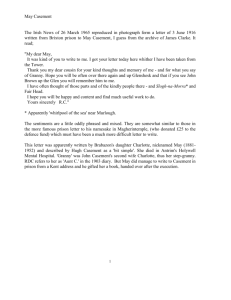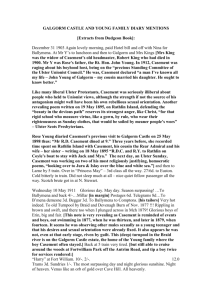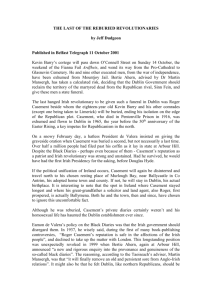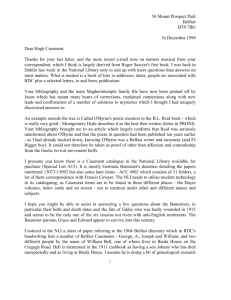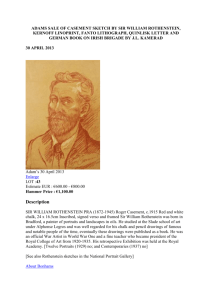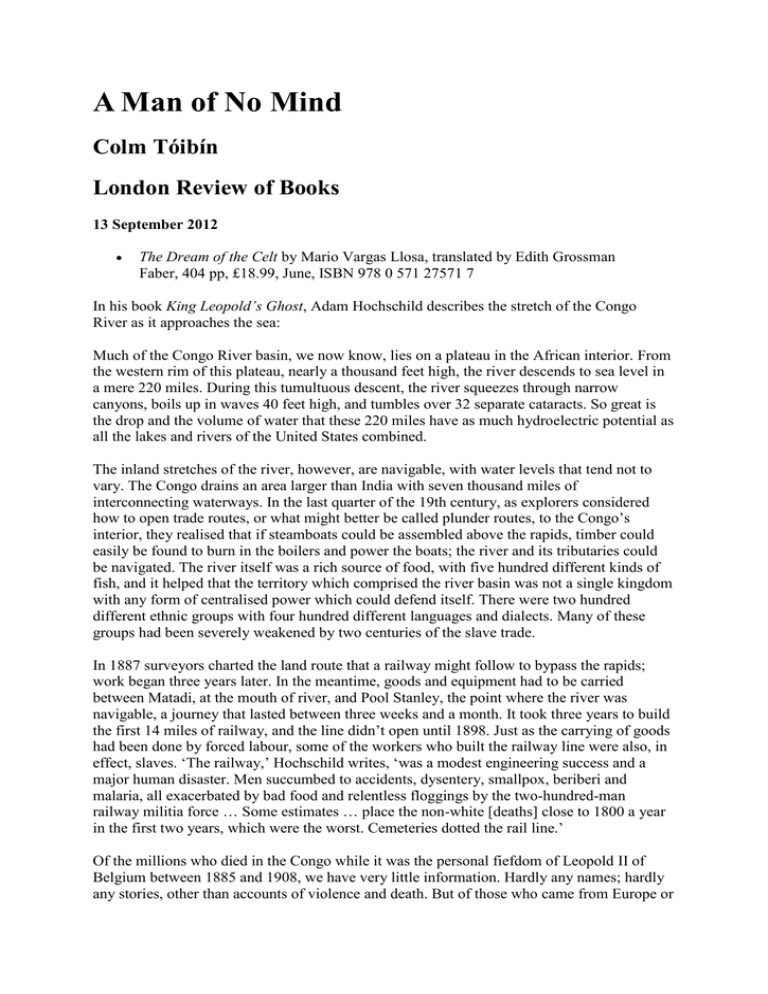
A Man of No Mind
Colm Tóibín
London Review of Books
13 September 2012
The Dream of the Celt by Mario Vargas Llosa, translated by Edith Grossman
Faber, 404 pp, £18.99, June, ISBN 978 0 571 27571 7
In his book King Leopold’s Ghost, Adam Hochschild describes the stretch of the Congo
River as it approaches the sea:
Much of the Congo River basin, we now know, lies on a plateau in the African interior. From
the western rim of this plateau, nearly a thousand feet high, the river descends to sea level in
a mere 220 miles. During this tumultuous descent, the river squeezes through narrow
canyons, boils up in waves 40 feet high, and tumbles over 32 separate cataracts. So great is
the drop and the volume of water that these 220 miles have as much hydroelectric potential as
all the lakes and rivers of the United States combined.
The inland stretches of the river, however, are navigable, with water levels that tend not to
vary. The Congo drains an area larger than India with seven thousand miles of
interconnecting waterways. In the last quarter of the 19th century, as explorers considered
how to open trade routes, or what might better be called plunder routes, to the Congo’s
interior, they realised that if steamboats could be assembled above the rapids, timber could
easily be found to burn in the boilers and power the boats; the river and its tributaries could
be navigated. The river itself was a rich source of food, with five hundred different kinds of
fish, and it helped that the territory which comprised the river basin was not a single kingdom
with any form of centralised power which could defend itself. There were two hundred
different ethnic groups with four hundred different languages and dialects. Many of these
groups had been severely weakened by two centuries of the slave trade.
In 1887 surveyors charted the land route that a railway might follow to bypass the rapids;
work began three years later. In the meantime, goods and equipment had to be carried
between Matadi, at the mouth of river, and Pool Stanley, the point where the river was
navigable, a journey that lasted between three weeks and a month. It took three years to build
the first 14 miles of railway, and the line didn’t open until 1898. Just as the carrying of goods
had been done by forced labour, some of the workers who built the railway line were also, in
effect, slaves. ‘The railway,’ Hochschild writes, ‘was a modest engineering success and a
major human disaster. Men succumbed to accidents, dysentery, smallpox, beriberi and
malaria, all exacerbated by bad food and relentless floggings by the two-hundred-man
railway militia force … Some estimates … place the non-white [deaths] close to 1800 a year
in the first two years, which were the worst. Cemeteries dotted the rail line.’
Of the millions who died in the Congo while it was the personal fiefdom of Leopold II of
Belgium between 1885 and 1908, we have very little information. Hardly any names; hardly
any stories, other than accounts of violence and death. But of those who came from Europe or
America in search of work or money or fame, many names emerge clearly: some because of
their cruelty or greed, others because of the strangeness of their backgrounds, or the lives
they lived and the causes they espoused. The three of these who stand out most are Henry
Morton Stanley, who explored the route, the novelist Joseph Conrad, and the Irish patriot and
human rights activist Roger Casement.
It was Casement and a Frenchman living in England, E.D. Morel, who first drew attention to
the crimes committed in the Congo in the name of progress and trade. Mario Vargas Llosa
wrote about them in an essay published in 2001: ‘Both deserve the honours of a great novel.’
Such a novel would have to live in the shadow of the short work Conrad produced nine years
after he left the Congo, where he had been for six months. Conrad arrived in June 1890.
‘What makes me rather uneasy,’ he wrote to a friend, ‘is the information that 60 per cent of
our Company’s employees return to Europe before they have completed even six months’
service.’ Conrad’s journey to his steamship from the coast by foot, with 31 Africans as
porters, took from 28 June to 1 August. At one point in his very sketchy diary, he noted: ‘On
the road today passed a skeleton tied up to a post. Also white man’s grave – no name – heap
of stones in the form of a cross.’ Conrad then travelled from Kinshasa to Stanley Falls on the
steamship Roi des Belges, a journey of a thousand miles, to bring back a company agent
called Klein who was close to death. Unlike Marlow in his story, Conrad wasn’t in charge of
the ship; his journey was rather more prosaic than the one in Heart of Darkness and Klein
much more ordinary than Kurtz. Although Conrad later claimed that the story was
‘experience pushed a little (and only very little) beyond the facts of the case,’ he also
admitted to Roger Casement in 1903 that it was ‘an awful fudge’, bearing little resemblance
to his experience. He found a style for the book that was far from the style of his diary: poetic
and stilted, awed and solemn, depending on voice, rhythm and the controlling of time and the
use of powerful and stark images and odd details. He invented a narrator who was not
himself. He didn’t set out to dramatise an enterprise that might be reformed but to expose the
abiding and mysterious sense of evil at the heart of the human enterprise itself. His story
shows the distance which fiction can go: how accurate and enduring it can be when it allows
substance and shadow to nourish each other, and yet how ambiguous it remains when we read
it as a version of what happened.
The value of Congo was at first its ivory. But in 1888, John Boyd Dunlop, an Ulster Scot
living in Belfast, made a discovery which would make the Congo Basin one of the most
lucrative places on earth. In The Devil’s Milk: A Social History of Rubber, John Tully
describes the moment when Dunlop
took his son’s bicycle into his workshop and equipped it with primitive pneumatic tyres made
of cloth wrappings and inflated lengths of rubber sheeting. The other children laughed at the
bulbous wheels, but their derision soon turned to admiration when Dunlop Junior was able to
comfortably navigate rough surfaces with a greater turn of speed than they had imagined
possible. The new tyres were soon afterwards used in cycle races with the same effect and the
guffaws of spectators subsided into respectful murmurs.
By 1895 there were seven million bicycles worldwide, using most of the world’s rubber.
Soon the automobile created even more demand: in 1910 the United States was building two
hundred thousand cars a year; by 1920 the figure was two million. The problem was that
rubber didn’t grow in places where it could easily be collected: it grew most abundantly in
the tropical forests of the Congo and Amazon basins. Since there were no roads in these
areas, the rubber would have to be carried long distances under appalling conditions. The
Congo was under the direct and personal control of Leopold II, which meant that the
treatment of those who did the carrying was not tempered by any law or set of humane rules.
The transporters were flogged and tortured, had their hands amputated, were raped, held
hostage and murdered as a matter of course. Their fragile society was decimated. More or
less the same happened in the Putumayo in Peru, organised by a company registered in
London. This is how we got the bicycle and the car until rubber was planted in more
accessible places.
Mario Vargas Llosa had this to say to an interviewer about the figure of Roger Casement,
who wrote reports for the British governments on atrocities in Peru as well as the Congo:
He is a man without any trace of self-interest, without any political or professional ambition.
He was extraordinarily generous. He had a set of values that were both very strict and based
on solidarity. At the same time, there is the man who appears in the diaries, the mysterious
Roger Casement. We do not know how much of himself we put into those diaries, or whether
they were also a fantasy, a fiction through which he attempted to fill the emptiness of his life
… He was a hero, of course; he was a man of admirable courage, of extraordinary moral
conviction, who had the tenacity to live this secret double life. But he was also a weak
person, whose body was sometimes at odds with values he espoused. He evidently could not
contain or restrain certain behaviours, and this, I think, is what makes him a tragic hero, a
hero who generates discomfort among even those Irish nationalists who would otherwise
have identified with him more readily.
There is another version of Casement’s personality, offered by Conrad in the spring of 1916
in a letter to John Quinn, when Casement was on trial for treason for importing arms to
Ireland from Germany. Conrad had spent three weeks at Matadi Station with Casement in
1890, when Casement was trying to recruit labour to work on the railway and Conrad was
waiting to begin his journey by foot to his boat. They also met subsequently in England.
Conrad’s version of Casement has to be viewed with care, since he wouldn’t have been in
sympathy with a man who had sided with Germany in the First World War, but his
description is interesting: ‘He was a good companion; but already in Africa I judged that he
was a man, properly speaking, of no mind at all. I don’t mean stupid. I mean that he was all
emotion … A creature of sheer temperament – a truly tragic personality: all but the greatness
of which he had not a trace. Only vanity. But in the Congo it was not visible yet.’
While Casement in all his complexity might indeed ‘deserve the honours of a great novel’,
that very complexity, as it has been argued about in the last decade or so, could itself be a
useful theme for a novel. Casement was a fanatical Irish nationalist who left Ireland at the age
of 16 and spent very little time in the country again. He dreamed about Ireland when he
worked as a British diplomat and the more he dreamed the more passionate he became about
Irish freedom and the revival of the Irish language. He worked to help colonise the Congo,
implicating himself in the very activity of which he later became a formidable and public
enemy. He was an energetic and meticulous campaigner against the abuse of the native
population of the Congo and the Amazon Basin; he also kept a diary in which he noted his
sexual adventures with native young men, many of whom he paid. When the First World War
broke out he developed a quixotic scheme to recruit Irish-born prisoners of war in Germany
into a brigade to fight the British. In April 1916, a few days before the Easter Rebellion
began in Dublin, Casement arrived in a submarine on the coast of County Kerry with guns
from Germany. He was arrested and charged with treason. Some of those who pleaded for
mercy for him were shown his diaries, which had been found among his possessions in
London. He was hanged in August 1916. From the very beginning, anyone who has written
about him has brought their own prejudices or personal histories to bear on the story.
Vargas Llosa is excellently placed to write a novel about such a strange and complex figure.
His best novels display extraordinary sympathy and a complex command of styles; the
dramatisation of the conflict between the individual and larger political forces has been one
of his themes. And he is deeply alert to the tricks and ironies of history, how our version of
what happened shifts and slips into a lovely fictional unreliability according to our needs. As
an essayist, he has written with great intelligence about the systems available to the novelist,
the forms and tones which have been inherited from the 19th century and how they might be
put to use now. Working out how to handle a figure as mercurial as Casement; placing him in
the context of the rush for rubber in all its violence and greed; dramatising his dreamy
fanaticism about Ireland and his steely determination to stop the atrocities in the Congo and
Peru; attempting to integrate his sexual adventures into the narrative; describing his mad
journey to Germany and his desperate months in prison awaiting execution: all of this should,
on the basis of his previous work, have come naturally to Vargas Llosa.
One of the methods available to him was the one he used in his novel The Real Life of
Alejandro Mayta (1984), in which the narrator tries to discover or disentangle the truth about
an insurrection in the Andes. He conducts interviews, finds clues, works like a detective. ‘I
wonder if we ever really know what you call History with a capital H,’ one informant says.
‘Or if there’s as much make-believe in history as in novels.’ The novel plays with the Spanish
word ‘historia’, which means both history and story, establishing a pattern of images and
information that is all the more textured and fascinating because it is so uncertain, blurred,
almost playful. The novel also introduces the idea of a secret homosexuality to add spice to a
narrative about political conspiracy. In one brilliant scene, Mayta and the younger Anatolio
discuss revolutionary strategy while lying beside one another in the dark, Mayta moving
closer and closer to his innocent comrade and sexual prey:
His face was very close to the boy’s bare shoulder. A smell, strong and elemental, of human
flesh assailed his nose and made him dizzy. His bent knees grazed Anatolio’s leg. In the
semi-darkness, Mayta could just barely make out Anatolio’s unmoving profile. Did he have
his eyes open? His breathing made his chest move rhythmically. Slowly, he stretched out his
moist and trembling right hand, and feeling around, he found Anatolio’s trousers.
The scene is spliced with another, in which the narrator interviews a senator who explains
about Mayta:
And, last but not least, there is one other matter we haven’t gone into, but that, if we want to
get to the bottom of things, we’re going to have to bring up … You know that Mayta was a
homosexual, of course … That’s how they got him up against the wall and made him work
for them. His Achilles’ heel. All he had to do was give in once. What could he do then but go
on collaborating … Perhaps the explanation is in all that … Is it possible to be sure of a
homosexual? An incomplete, feminine being open to all kinds of weakness, and that includes
being an informer.
In his first novel, The Time of the Hero (1963), Vargas Llosa similarly sought to entwine the
sexual and the political, as the atmosphere of violence and repression in a military academy
makes its way almost naturally into the sexual realm. There is a marvellous scene in which
the student cadets fuck a chicken.
But the book by Vargas Llosa which offers the most interesting connection to his latest novel
is The War of the End of the World (1981), perhaps his greatest achievement as a writer of
fiction. It is set in the late 19th century, and like The Dream of the Celt it deals with the clash
between forces, one of which might be seen as primitive, while the other relies – or claims to
rely – on reason and technology. Both novels are filled with violence and foreboding and
evoke an alien landscape in detail. They both deal with a remote part of the world that is
being invaded by outsiders who don’t see the natives as fully human. Both books use wellknown sources. The Dream of the Celt uses Casement’s diaries and his official reports; The
War of the End of the World uses Euclides da Cunha’s Rebellion in the Backlands, originally
published as Os Sertões, a chronicle of the Brazilian army’s campaign against a rebellious
village in the interior, considered a masterpiece of Brazilian literature. Both novels have a
European outsider as one of the protagonists: we see the conflict through his eyes, but we
also get a glimpse into his consciousness and complex set of beliefs, or in the case of
Casement more than a glimpse. ‘This is an important aspect of our history,’ Vargas Llosa
wrote in an essay on The War of the End of the World, ‘foreigners who come to Latin
America and see not what Latin America is but what they would like Latin America to be so
that they may satisfy their personal visions.’ He makes it clear that in writing the novel he felt
‘free to change, deform and invent situations, using the historical background only as a point
of departure to create what essentially would be a fiction, that is, a literary invention’. The
invading army was well documented but ‘the rebel side was not documented at all … There
were no documents written by the rebels … All this gave me a great opportunity to invent, to
fantasise about what happened to the rebels.’
In another essay, Vargas Llosa asks what can make a novel soar above the material that gave
rise to it: ‘Differentiating between what is and what is not a novel comes down to whether it
is possible for the text to become independent of reality, to have a life of its own. When you
read War and Peace you have no personal experience to verify what the novel tells you, but
the power of the novel is such that you are persuaded of its true reality.’ In The War of the
End of the World, in Helen Lane’s translation (which the author, perhaps with his tongue in
his cheek, asserts ‘may be better than the original’), there is a sweeping confidence in the
rhythms, a brilliance in the choice of detail and the analysis of motives; a wonderful
complexity is given to character and event. Something emerges from the book that not only
soars above the sources Vargas Llosa used, but also above his own careful structuring and
narration, and it has a rare tragic force that is grave and deeply affecting.
The problems with The Dream of the Celt begin with the first paragraph, which is a faithful
translation by Edith Grossman:
When they opened the door to his cell, the street noise that the stone walls had muffled came
in along with the stream of light and a blast of wind, and Roger woke in alarm. Blinking, still
confused, struggling to calm down, he saw the shape of the sheriff leaning in the doorway.
His flabby face, with its blonde moustache and reproachful little eyes, contemplated him with
a dislike he had never tried to hide. This was someone who would suffer if the English
government granted his request for clemency.
While there are some small problems here with the translation, such as the use of ‘stream’ so
close to ‘street’ and ‘tried to hide’, which might have been better as ‘attempted to hide’, the
main problem is one of confusion about point of view, and it’s embedded in the original. If
the sheriff has his back to the light, how can Casement, who is barely awake, see him so
closely and in such detail, unless there is another narrator, another set of eyes in the room
seeing everything? Since the novel is told entirely from Casement’s point of view, it is vital
to establish from the beginning that there is no other narrator. For a moment, too, it is
possible for the reader to believe that it is Casement who has the flabby face, since he is the
one doing the seeing in the previous sentence and thus may well be doing the contemplating
in the next. Also, a face cannot contemplate and a flabby face even less so. Also, a blast of
wind (‘un golpe de viento’) seems a bit strong, since the corridor outside is indoors. It is hard
to imagine that what Casement felt was actually ‘a blast of wind’; it was more likely to have
been a sense or a feeling of fresh air, or air different from the stale air in the stuffy cell.
The book’s epilogue presents a more serious problem. It is narrated in a clunky tone by the
author himself, and considers Casement’s diaries:
Did they really exist and did Roger Casement write them in his own hand, with all their
noxious obscenities [‘sus obscenidades pestilentes’], or were they falsified by the British
secret service to execute their former diplomat both morally and politically in order to create
an exemplary warning and dissuade potential traitors? … My own impression – that of a
novelist, obviously – is that Roger Casement wrote the famous diaries but did not live them,
at least not integrally, that there is in them a good deal of exaggeration and fiction, that he
wrote certain things because he would have liked to live them but couldn’t.
The phrase ‘that of a novelist, obviously’ is disingenuous. It seems to offer Vargas Llosa a
licence to think whatever he wishes and not have to consider the evidence or offer any
arguments to support his thoughts. He is here giving his fixed opinion on Casement’s diaries
as real documents rather than letting us know what he chose to do about them in his
imaginative reconstruction of Casement’s life, in the absolute freedom of the novel. It isn’t
clear what he means by ‘at least not integrally’ (faithfully translated from ‘no por lo menos
integralmente’).
The Dream of the Celt has none of the sweep and forceful rhythmic power of The War of the
End of the World. The tone is more intimate and slower, all the more precisely to capture
what Casement saw and noticed, what he felt and remembered. Vargas Llosa uses free
indirect style, which he described in a book on Flaubert as
the style always employed to give an account of intimate facts (memories, feelings,
sensations, ideas) from the inside, that is to say, to bring the reader and the character as close
to each other as possible … By relativising the point of view, the style indirect libre finds a
way into the character’s innermost depths, little by little approaching his consciousness,
drawing closer and closer as the intermediary – the omniscient narrator – appears to vanish in
thin air. The reader has the impression of having been introduced into the deepest recesses of
the characters, to be listening, seeing consciousness in movement before it turns into oral
expression.
This style is what gives The Dream of the Celt its intensity, but it also means that the chance
to represent the world of the Congo and the Putumayo, all the people who were forced to
work carrying rubber, is lost. Panorama has been replaced by intimacy, and while this has
been done, for the most part, with skill and care, something much larger has been sacrificed.
Another problem with this intimate method is that because the novel lives inside Casement’s
head and nudges us towards doing the same, we are asked to take Casement seriously all the
time, since he takes himself seriously in the prison cell as he awaits word of possible
clemency in the chapters with uneven numbers, and as his life appears in flashback in the
even-numbered ones. We are asked to take his feelings about Ireland – a country he barely
knew and only romanticised – as seriously as his memories of what he saw in the Congo and
the Putumayo. Casement here becomes the figure in Conrad’s letter to John Quinn, ‘a man,
properly speaking, of no mind at all … all emotion’. His thoughts on Ireland lack substance;
because they can’t be handled comically, or viewed by anyone other than the humourless
Casement himself, as the novel proceeds they become repetitive and tedious.
In Germany, Casement was accompanied by a young, good-looking and treacherous
Norwegian. His time there, which included many subplots and escapades, needs a comic
novelist such as Evelyn Waugh, J.G. Farrell or indeed the Mario Vargas Llosa of The Time of
the Hero or Aunt Julia and the Scriptwriter rather than this ponderous stylist. In Germany
Casement hoped to meet Irish prisoners of war filled with the same spirit of romantic
nationalism and idealistic love of country he felt himself. He was in for a shock. It was only
when he had to face the idea of meeting them rather than imagining them that it occurred to
him that they had willingly joined the British Army, and could easily therefore be ‘the scum
of Ireland’. When he made his proposal to the men that they should establish an Irish Brigade
and fight for Germany, ‘he seems to have been jostled and to have needed protection from his
German guards,’ Séamus O Síocháin writes in Roger Casement: Imperialist, Rebel,
Revolutionary, the best biography of Casement. Casement wrote: ‘I very soon saw, from the
manner of the men, that all hope of an Irish Brigade from such a contemptible crew … must
be entirely abandoned. Some of them insulted me – but all showed clearly the utter slothful
indifference of that type of debauched Irishman to any appeal but his greed.’ Later, he was
unwilling to see them again: ‘I will not return to Limburg to be insulted by a handful of
recreant Irishmen … I cannot meet insults from cads and cowards with insults. I can only
avoid the cads and cowards.’ An Irish student who met Casement at this time remembered:
‘He seemed in an extreme “fidget”, and impressed me as a very impulsive, excitable man.’ In
one of the meetings in the prison camp, a prisoner asked him: ‘How much are the Germans
paying you?’ Casement called the man a scoundrel and walked out. So much for the dream of
the Celt.
Vargas Llosa’s views on what are known as the Black Diaries do more damage to the novel,
however, than his heavy-handed treatment of Casement’s Irish dreams and his German
sojourn does. In his careful appendix to the diaries O Síocháin writes:
If one accepts the existing evidence from outside the diaries for Casement’s homosexuality
… if one accepts that the type of homosexual lifestyle depicted in the diaries conforms to
what today is a recognisable variant; and if one accepts that Casement directed his moral
wrath not at sexual behaviour but at individuals or institutions he considered to be oppressive
of individuals or communities, then we begin to see many of the references to Casement’s
‘dividedness’ in a new light. Claims that the author of the diaries is ‘subhuman’, ‘moronic’,
‘schizoid’, can then be seen for what they are: reflections of the moral positions of those
making the judgments rather than of Casement’s morality.
Vargas Llosa strongly believes that Casement was ‘divided’, his body ‘sometimes at odds
with values he espoused’. He is, of course, entitled to take whatever moral position on
Casement’s sexual activities he wishes to take; if he wants to read the entries in the Black
Diaries as ‘noxious obscenities’ then he is free to do so. But the idea that Casement wrote the
entries ‘but did not live them, at least not integrally, that there is in them a good deal of
exaggeration and fiction, that he wrote certain things because he would have liked to live
them but couldn’t’ does not stand up to much scrutiny. More important, it means that Vargas
Llosa as a novelist is writing about a reduced fictional figure. In his version of the story the
Casement travelling in the Congo and the Putumayo is a great humanitarian, a man filled with
zeal, with deep and horrified concern, a more passionate and effective Kofi Annan. In most of
the narrative, Casement is not only simplified, which any novelist has a right to do with a
figure from history, but he is simple, not of much interest – which is a different matter.
Were the diary entries written about things that didn’t happen, but belonged instead in the
realm of the wishful, then they would surely have a much greater erotic charge than the
scribbled notes that Casement wrote. Most of the entries merely record the transaction,
sometimes with a reference to the size of the companion’s penis, the amount of money paid
and the location where the sex took place. Sometimes there is another cryptic comment;
occasionally an entry is entirely cryptic. Vargas Llosa’s question in his epilogue about the
possibility of these notes having been ‘falsified’ is hardly worth asking. O Síocháin, having
considered all the evidence, concludes that ‘the various pieces of evidence, positive and
negative, suggest that the Black Diaries are the work of Roger Casement’ and could not have
been forged.
Vargas Llosa’s efforts to evoke Casement’s childhood in Ireland are at the sugary end of
historical novel writing. There are moments where it is hard not to feel that Jean Plaidy and
Georgette Heyer had a hand in the book’s creation. The young Casement
heard for the first time the epic battles of Irish mythology. The castle of black stone, with its
fortified towers, coats of arms, chimneys, and cathedral-like façade, had been built in the 17th
century by Alexander Colville, a theologian with an ill-favoured face – according to his
portrait in the foyer – who, they said in Ballymena, had made a pact with the devil, and
whose ghost walked the castle. On certain moonlit nights, a trembling Roger dared to search
for him in passageways and empty rooms but never found him.
Roger also ‘enjoyed the outdoors, the robust elms, sycamores and beech trees that resisted the
hurricane-force wind, the gentle hills with cows and sheep where one could see the town of
Ballycastle, the ocean, the breakers crashing into Rathlin Island, and, on clear days, the
blurred silhouette of Scotland’.
In Africa, Casement, in Vargas Llosa’s version, learned to look but not to touch. In the novel,
in Luanda, as he works on the report about the Congo, charting the most savage atrocities,
Casement notices ‘several half-naked natives’ and observes that one of them ‘was very
beautiful … With the movements he made as he carried the load on his shoulder from the
wagon to the interior of the storehouse, the light piece of cloth he wore around his hips
opened and offered a glimpse of his sex, reddish and hanging and larger than normal.’
Casement then writes in his diary, inventing the sex: ‘He was mine, I was his. I howled.’
Later, as the novel proceeds, there is some real sex, but the scene as Vargas Llosa describes it
is followed by ‘the profound sadness that almost always followed his furtive amorous
encounters, generally outdoors, like the first one, with men or boys who were often foreigners
whose names he did not know or forgot as soon as he learned them’. On this same page,
Casement recounts to himself that he had ‘many lovers for a price – dozens, perhaps
hundreds – and not a single loving relationship. Pure sex, hurried and animal.’ The problem
with this, which occurs on page 249 of the English text and 283 of the Spanish, is that we
have been in Casement’s mind for a long time but have not been told on what days he had
these ‘dozens, perhaps hundreds’ of encounters and where they happened and what they felt
like at the time. They have not been incorporated into the drama of the novel: they are offered
to us as an afterthought.
Ireland, in the meantime, remains on Casement’s mind. This is partly thanks to the Irish
historian Alice Stopford Green, who is the occasion of one of the worst sentences, faithfully
translated here, in the entire novel:
In those early months of 1904, Alice Stopford Green was his friend, his teacher, the woman
who introduced him to an ancient past where history, myth, and legend – reality, religion, and
fiction – blended together to create the tradition of a people who continued to maintain, in
spite of the denationalising drive of the Empire, their language, their way of being, their
customs, something which any Irish man or woman, Protestant or Catholic, believer or
doubter, liberal or conservative, had to feel proud and obliged to defend.
On a trip back to Ireland, Casement sees again the ‘elms and beech trees dominating the
meadows where sheep lay, and beyond that the sea, the view of the island of Rathlin and the
small city of Ballycastle [‘la pequena ciudad de Ballycastle’] with its snow-white cottages’.
All of this ‘moved him deeply’. Later it gets worse when he goes to the west of Ireland:
‘During those months he had made a long trek through Donegal and Galway, taking the pulse
of the geography of his captive homeland, observing like a lover the austerity of her deserted
fields and wild coast, chatting with her fishermen, fatalistic, unyielding men, independent of
time, and her frugal, laconic farmers [‘sus campesinos frugales y lacónicos’].’ This sort of
writing is very close to an earlier tone of Vargas Llosa’s. It is the tone that Pedro Camacho
uses in his broadcasts in Aunt Julia and the Scriptwriter. The broadcasts are written, as
Vargas Llosa notes in an essay on the book, ‘in pretentious language; language that pretends
to be literary.’ The tone is an open and ingenious parody of such language; it is brilliantly
comic in the earlier novel, managing to subvert cliché by deliberately using as much of it as
possible; in The Dream of the Celt, on the other hand, cliché is used seriously, indeed
solemnly.
Casement, like Vargas Llosa himself, was in possession of many different tones. His reports
for the British government on atrocities in the Congo and Peru were written in language of
restraint and sobriety. His indignation was deeply controlled. He used detail with cold care
and was concerned with accuracy, with information that could not be disputed. He was no
longer Conrad’s man ‘of no mind at all’ as he worked on his reports. Casement’s legacy rests
on this work, on his generosity and his steely will. But Casement’s legacy is more complex
than the work he did as a humanitarian. For a biographer, there is a need for an understanding
of his sexuality in all its energy and compulsion and its connection to the energy and
compulsion he showed in other areas of his life. A novelist needs such an understanding too –
or perhaps an even deeper understanding, as Vargas Llosa himself seemed to suggest at the
end of an interview he gave about the book in Lima in December 2010: ‘He is a character
who is difficult to accept in his entirety, in his complexity, in his diversity. And I think it was
this difficult, contradictory personality – at once so compelling and repellent – that made me
think about him a great deal, and made me try and imagine him, and which led me, in some
way, to invent him.’

